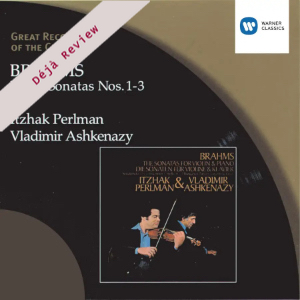
Déjà Review: this review was first published in July 2003 and the recording is still available.
Johannes Brahms (1833-1897)
Violin Sonata No. 1 in G, Op. 78 (1879)
Violin Sonata No. 2 in A, Op. 100 (1886)
Violin Sonata No. 3 in D minor, Op. 108 (1888)
Itzhak Perlman (violin)
Vladimir Ashkenazy (piano).
rec. 1983, Studio No. 1, Abbey Road, London
Originally reviewed as EMI Classics 7 47403 2
Warner Classics 5668932 [69]
Brahms’ three great outpourings for violin and piano represent pinnacles of the violin’s chamber repertoire, and it is a pleasure to welcome Perlman and Ashkenazy’s traversal as part of EMI’s Great Recordings of the Century series. Inspiration was obviously caught on the wing, for all three sonatas were put down in the space of four days: with Christopher Parker as engineer and Suvi Raj Grubb as producer. The credentials of the recording team are impeccable. Indeed, the recorded sound seems to capture the two artists’ individual sounds remarkably. Whether Ashkenazy as pianist appeals is a highly personal matter, for his tone can be shallow (perhaps too much so for this repertoire). That said, the two instrumentalists work together with just the right amount of give and take and their understanding of the Brahmsian sound-world is so sure and firm that this misgiving really pails into insignificance.
Perlman’s warm tone suits the G major sonata’s wistful air well, and both players are intimate enough with the work to let it unfold at its own pace. The Adagio brings beautiful stopping from Perlman and perfectly judged chording from his pianist, but it is the finale that, aptly, proves the emotional climax. Perlman’s playing in particular is warm and unaffected.
Ashkenazy eases into the Sonata No. 2 as if from nowhere. The sonata appears fully self-confident yet unutterably contented here. Only in the more dynamic chordal exchanges could Ashkenazy have imbued the sound with more depth of tone; but his playfulness in the second movement more than makes up for this.
Perhaps the first movement of the mighty D minor sonata is the weak point of the set. Despite the aching lyricism of the opening, concentration dips, an occurrence all the more striking given the rapt, interior account of the Adagio. Nice how the third movement creeps its way in, quite in keeping with its playful, skittish nature. The finale is dynamic and strong (especially on Perlman’s side).
As a collection of the three violin sonatas on one disc, this disc has an enormous amount to recommend it. It should not, perhaps, be the only set of these pieces in one’s collection; indeed, there is a performance of the Third Sonata by David Oistrakh and Vladimir Yampolsky that provides an ideal companion to Perlman/Ashkenazy (review), but it remains a version to return to on a regular basis.
Colin Clarke
If you purchase this recording using a link below, it generates revenue for MWI and helps us maintain free access to the site



















